Visit your favourite destinations |
| A Report from birdtours.co.uk |
Vatera- Lesvos 27th April - 9th May ,
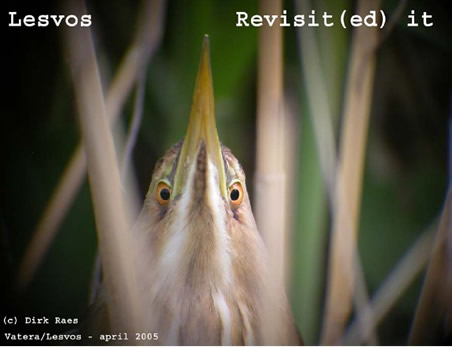
For the fourth time I paid a visit to Lesvos, especially to the area of Vatera, South Lesvos. After a winter visit in early January 2003, followed by spring (April) 2003 and spring 2004 (10 April – 2 May) this time a flight brought me, late on April the 27th until May the 9th early morning, towards this great island.
| As usual I was staying at Vatera (Madonna Studios e-mail: madonna@otenet.gr), an excellent place to discover the rich-on-nature South of Lesvos and which is ideal for birdwatching and walking holidays.. |
The first day, 28th. taught me that Black-headed Bunting arrived already and their numbers became only higher the next days. A walk to the river Almiropotamos (west of Vatera) proved to hold still a lot of water, which couldn’t be said for the rest of the island. The next 2 weeks the river held Little Bittern, Night Heron, Squacco Heron, Little Egret, Great White Egret, Grey Heron, Purple Heron, Black Stork, Marsh Harrier, Little Ringed Plover, Little Stint, Ruff, Greenshank, Wood Sandpiper, Common Sandpiper. The news goes that also Great Snipe was seen.
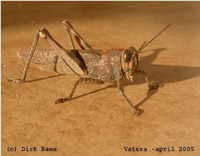 |
Also attention was paid to something else like dragonflies, grasshoppers etc… during the extensive walks. |
Around Vatera, the usual birds were seen. Just some to mention: Mediterranean Shearwater, on Saturday the 30th of April several hundreds as a gale force 7 was blowing. Regular also in the sky were Common Buzzard, Long-legged Buzzard, Peregrine and Booted Eagle. Several observations of Red-footed Falcon (1, 4 and 4) and Eleonora’s Falcon (always 1 bird) were made. East of Vatera you can find the river Vourkos, a river this year with almost no water in it. A walk in the riverbed produced Little Bittern at 5m. (See top picture) and also the Little and Squacco Egrets.
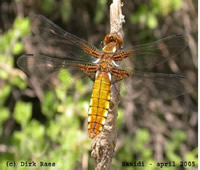 |
During all these walks birding proved to be very successful as you can take time and spot birds, butterflies and dragonflies very close. |
Having decided this year to explore on foot this southern area, it gave me big satisfaction. Walks and short car visits around Vatera (the area Paleochori – Raxidi – Drota - Agiasos – Skala Vasilikon - Skamnioudi – Alikoudi – Skala Polychnitos - Nifida) brought Garganey, Lesser Kestrel, Goshawk, Black-winged Stilt , Avocet, Kentish Plover, Mediterranean Gull, Yellow-legged Gull, Common Tern, White-winged Black Tern (34 near Alikoudi-pool), Cuckoo, Swift and Alpine Swift, Bee-eater (51 on migration), Roller (2 near Ag. Fokas), Middle Spotted Woodpecker, Sand Martin, Crag Martin, Swallow, Red-rumped Swallow, House Martin, Tawny Pipit (4 near Nifida), Grey Wagtail, Wren, Nightingale, Whin- and Stonechat, Black-eared Wheatear, Blue Rock Thrush (breeding in Vatera), Cetti’s Warbler, Reed and Great Red Warbler, Olivaceous, Sardinian and Subalpine Warbler, Semi-collared Flycatcher (Raxidi), Kruper’s Nuthatch (Agiasos), Red-backed and Woodchat Shrike, Jay (var. atricapillus) , Raven (up to 16 nearby Alikoudi), Hawfinch, Cirl, Cinereous and Cretzchmar’s Bunting.
 |
This holiday was planned - as said - to be a relaxing, a walking one with some birding en-route but also an eye for orchids. These proved to be well over 15 species and time was taken to ‘digitalize’ them. |
One day I went to the Kalloni Saltpans [39°13’N, 26°16’E) the south (so called dead-end track). After a week of quite on-foot birding it’s amazing to see how people are birding these days. Several birders on foot had to step aside because other birders passed by car. Knowing that this is a dead-end track …. Yes, you’re right … again stepping aside!!
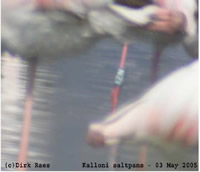 |
Anyway after 1 hour I got enough of this ‘behaviour’ and went off. The result was most amazing: 94 White-winged Black Terns, and most important 3 Greater Flamingo’s with colour-rings and also 5 cars. |
A quick review of these sightings (courtesy : Christophe Germain, Flamingo Database Manager, Tour du Valat, Arles, France ; Özge Balkiz, Doga Dernegi Flamingo Researches Officer ; Paolo Dall'Antonia, Istituto Nazionale per la Fauna Selvatica, Ozzano Emilia, Italia).
* Blue ring coded IZN: ringed on 02.07.2002 as a pullus in Saline di Commacchio, Ferrara, Italy.
* White ring coded T|AHS: ringed on 17.08.2003 as a pullus in Çamalti Tuzlasi, Gediz Deltasi, Izmir, Turkey.
None of these two birds have been seen elsewhere since the ringing.
* Yellow ring coded CSTJ: ringed on 30.07.97 as a pullus in Etg. du Fangassier, Bouches-du-Rhone, France.
This bird has been seen several times. Beginning August 1998 she spent in the Algarve, Portugal; June ’99 till November 2001 she stayed near Sevilla, Spain to make a visit on the 23.04.2002 to Malaga, Spain and come back to Sevilla in June 2002. She paid a visit to the Huelva-area in October 2003 to go back to the breeding area in April 2004. 03.05.2005: a summer on Lesvos?
Even more amazing was that none of all the birders on this spot (also a good, well known UK photographer) spotted these birds and have – of course – no eye for in-deep birding.
After my fourth stay on Lesvos – Vatera, this personal reflection: Birding is supposed to be a relaxing hobby, a way to escape the daily stress from today’s world and this in a calm environment. You can do this in Vatera.
But what happens?
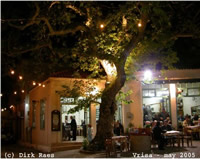 |
Instead, birding in Lesvos seems to reflect our modern world … driving around from bird to bird. Personally I prefer less species, but coming back home in an unstressed state and pick up my website European colour-ring Birding (www.cr-birding.be) |
Why not send us a report, or an update to one of your current reports?